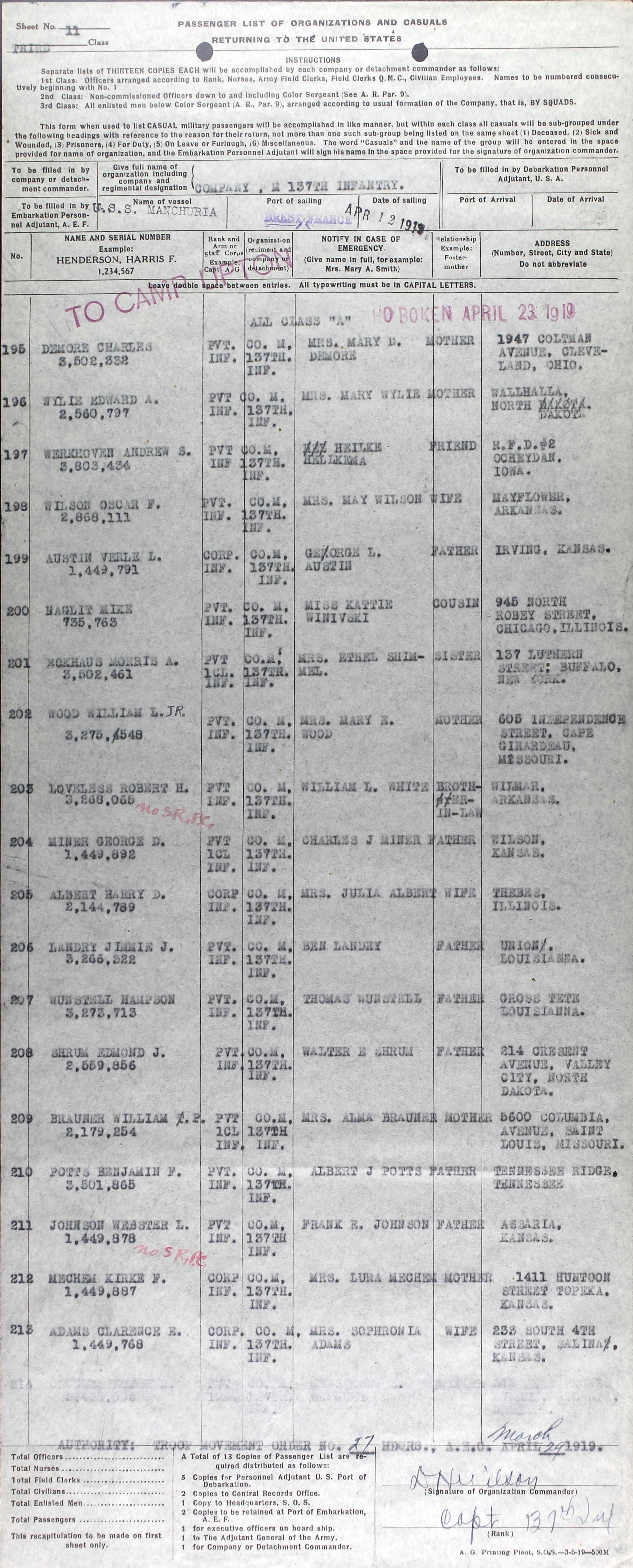With orders for home, the 137th Regiment boarded trains at Sampigny on March 7. They arrived in the Le Mans area three days later. The companies were dispersed to surrounding towns and villages, Company M to Monfort-les-Gesnois. Far from the desolate battlefields, the men enjoyed a couple weeks of “the best accommodations since [their] arrival in France,” whether in billets or private homes (Haterius, 197).
Following this respite, they moved to what was known as “the Belgian Camp,” where they slept in tents and were subjected to medical examinations, inoculations, and “cootie baths” to make them presentable to their mothers.
April 4, an overnight train from Champagne took the regiment to the coast at Brest, France’s westernmost port. After a week’s wait in cantonment, a morning march, loaded with all their gear, took them to the docks. From there, they were conveyed by light boats to a transport ship anchored a mile out in the bay. France, as its final farewell, drizzled rain on them.
The Manchuria steamed out of the bay, setting course for Hoboken, New Jersey. Haterius describes the vessel:
We were now on the good ship Manchuria, a former Pacific mail steamer which had plied between San Francisco and Hong Kong, China. This was her tenth voyage across the Atlantic. A brief description of her capacity: She had a length of 615 feet, displacement of 27,000 tons, took 1,056,000 gallons of fresh water, 40,000 tons of coal, sufficient for a round trip, two great engines, twelve boilers, thirty-six huge furnaces, and twin propellers. “Some baby” we agree. The compartments had all been taken out and bunks three high were crowded together, each section of three, two feet apart. It was somewhat crowded with 4,771 officers and enlisted men aboard. (202, 205)
The voyage was uneventful save for forty-foot waves on the sixth day, from which none were spared discomfort, and a holiday. On Sunday, April 20, the ship’s chaplain held Easter services on board.
Thanks to the journal-keeping Haterius, we know what meal Private B. F. Potts shared with his comrades that Sunday a century ago: “For our Easter dinner, beans were served—nothing more, nothing less—beans and beans only” (206).
The following day the troops spotted the first seabirds flying overhead. Two days later, they set foot on native soil.
 From the Manchuria’s Passenger List, April 12, 1919.
From the Manchuria’s Passenger List, April 12, 1919.
Although the “Date of Sailing” is recorded here as April 12, according to Haterius, the 137th boarded on the 11th, waited throughout the next day, and sailed on the 13th (205).
A Very Muddy Place
WAR STORIES
An intimate account of a soldier’s experience in World War I, A Very Muddy Place takes us on a journey from a young man’s rural American hometown onto one of the great battlefields of France. We follow Private B. F. Potts with the 137th US Infantry Regiment through the first days of the Meuse-Argonne Offensive. We discover a personal story—touching, emotional, unforgettable.
In 1918, twenty-three-year-old Bennie Potts was drafted into the US Army to fight in the World War. He served with the American Expeditionary Force in France. At home after the war, he married and raised a family, and the war for his children and grandchildren became the anecdotes he told them.
A century later, a great grandson brings together his ancestor’s war stories and the historical record to follow Private Benjamin Franklin Potts from Tennessee to the Great War in France and back home again.
Available in hardcover, paperback, and e-book.
Disclosure: This page and linked pages contain affiliate links to Bookshop, Amazon, Apple, Barnes & Noble, and Kobo. As an affiliate of those retailers, Stephen earns a commission when you click through and make a purchase. Thank you for your support.

